Click on images to enlarge
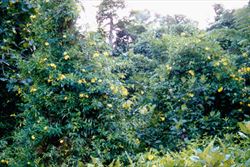
infestation climbing over vegetation (Photo: Land Protection, QDNRW)
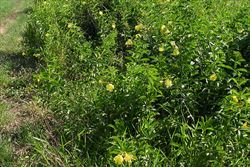
infestation along a roadside (Photo: Chris Gardiner)
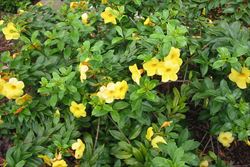
habit (Photo: Sheldon Navie)
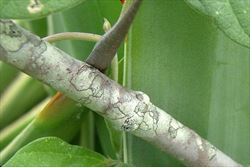
older woody stem (Photo: Sheldon Navie)

close-up of reddish stem and leathery leaves (Photo: Sheldon Navie)

flowers and leaves (Photo: Sheldon Navie)
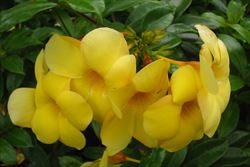
clusters of tubular yellow flowers (Photo: Sheldon Navie)
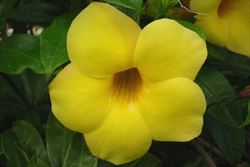
flower from front-on (Photo: Sheldon Navie)
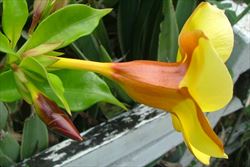
flower from side-on (Photo: Sheldon Navie)
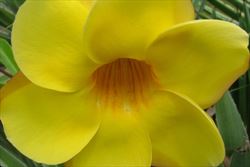
close-up of petal lobes and reddish lines in the throat of the flower (Photo: Sheldon Navie)
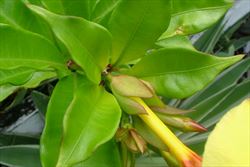
close-up of sepals and narrow base of the flower tube (Photo: Sheldon Navie)
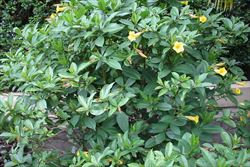
the shrubby habit and smaller flowers of Allamanda schottii (Photo: Sheldon Navie)
Scientific Name
Allamanda cathartica L.
Synonyms
Allamanda hendersonii Bull. ex DombrainAllamanda cathartica L. var. hendersonii (Bull. ex Dombrain) L.H. Bailey & Raffill.
Family
Apocynaceae
Common Names
allamanda, brownbud allamanda, buttercup flower, common trumpet vine, cup of gold, golden allamanda, golden cup, golden trumpet, golden trumpet flower, golden trumpet vine, golden-trumpet, Guinea herb, yellow allamanda, yellow bell, yellow trumpet vine
Origin
Native to tropical South America (i.e. Brazil, French Guiana, Guyana and Surinam).
Cultivation
Widely cultivated in gardens in Australia, particularly in sub-tropical and tropical regions. Numerous cultivars have been developed, which may range in flower colour from yellow to pinkish or even chocolate brown. It is particularly popular in the Cairns area, in northern Queensland, and some local businesses in this region have even incorporated it into their corporate identity.
Naturalised Distribution
Naturalised in the coastal districts of Queensland, and most commonly found in the northern parts of the state. There are herbarium records of this species from the Cook, North Kennedy, South Kennedy, Port Curtis and Moreton pastoral districts. Also naturalised in the coastal districts of northern Western Australia.
Naturalised overseas in China, south-eastern USA (i.e. Florida) and on several Pacific Islands (e.g. in American Samoa, Western Samoa, Fiji, Niue and Palau).
Habitat
Yellow allamanda (Allamanda cathartica) prefers moist, well-drained, soils in tropical regions. At present it is mainly a weed of roadsides and nearby bushland in the wet tropics of northern Queensland, but is also reported to grow along creeks and in disturbed natural vegetation in Western Australia.
Habit
A vine or shrubby plant with some climbing stems (i.e. scandent shrub). It often forms into a clump about 2 m tall and 2-3 m wide, but can grow much higher when climbing up over other vegetation (i.e. up to 6 m in height).
Distinguishing Features
- a vine or climbing shrub with milky sap.
- its leaves are leathery in nature and are usually arranged in groups of three or four along the stems.
- its large bright yellow flowers are trumpet-shaped with five spreading petal lobes.
- its rounded fruit capsules (about 4 cm across) are densely covered with soft spines (about 1 cm long).
Stems and Leaves
The older stems are mostly woody and brownish in colour, while the younger branches are generally green and hairless (i.e. glabrous). The stems and leaves both contain a milky sap (i.e. latex).
The simple leaves are arranged in groups of three or four along the branches (i.e. the leaves are whorled or verticillate). They are borne on very short stalks (i.e. petioles) only 2-5 mm long and have blades that are egg-shaped in outline (i.e. obovate) to somewhat elongated in shape (i.e. oblong-lanceolate). These leaves (5-17 cm long and 2.5-6 cm wide) have a narrowed (i.e. attenuate) base, entire margins, and a pointed tip (i.e. acuminate apex). They are somewhat shiny in appearance, relatively thick and leathery in nature, and hairless (i.e. glabrous).
Flowers and Fruit
The large flowers (7-11 cm long and 5-7.5 cm wide) have five bright yellow petals that are fused together at the base to form a tube (i.e. corolla tube) about 4-8 cm long. This tube has reddish markings on the inside and is topped with five spreading petal lobes. The flowers also have five sepals (8-22 mm long) that are fused into a much smaller, greenish-coloured, tube at their bases (i.e. a calyx tube). Each flower also has five stamens that are joined directly onto the inside of the petals (i.e. adnate to the corolla tube) and a long style with two small branches at its tip. The flowers are borne in loose clusters (i.e. cymes) near the tips of the stems, each containing about ten flowers. Individual flowers are borne on short stalks (i.e. pedicels) about 5-7 mm long and the petals (i.e. corolla lobes) are folded and twisted when in bud. Flowering probably occurs mostly during spring and summer.
The fruit are rounded (i.e. globose) capsules (about 30-75 mm across) that are densely covered with soft spines (about 1 cm long). These fruit are rarely seen in cultivated plants. The seeds are somewhat flatenned (i.e. compressed), tan in colour and are slightly winged or have a thin (i.e. membranous) margin.
Reproduction and Dispersal
This species reproduces by seed and can also be propagated via stems segments.
Yellow allamanda (Allamanda cathartica) is probably mainly spread in garden waste that is dumped along roadsides and in bushland. Its seeds are then dispersed from these initial infestations by wind and water. Stem segments may also be spread down waterways during floods.
Environmental Impact
Yellow allamanda (Allamanda cathartica) is regarded as an environmental weed in northern Queensland. It is one of a number of exotic ornamental vines that have become invasive in this region after escaping from garden plantings. This species was first recorded as naturalised in Queensland in 1945. By 1992, it was recognised as a weed of roadsides in the wet tropics region of northern Queensland, but it was not then considered to be a high priority environmental weed.
However, yellow allamanda (Allamanda cathartica) has continued to spread and is now widely naturalised in the rainforests of northern and central Queensland. It is now considered to be quite invasive in several National Parks in far northern Queensland and is common along roadsides between Silkwood and Tully. It also invades well-drained soils on the fringes of rainforests and paperbark swamps.
In fact, yellow allamanda (Allamanda cathartica) was recently ranked among the top 25 species on a prioritised list of weeds of the wet and dry tropics regions in northern Queensland. It is also listed as a priority weed in the Far North Queensland Natural Resource Management region, is a locally declared plant in Cardwell Shire, is regarded as an "undesirable plant" in the wet tropics World Heritage Area, and is thought to be adversely impacting upon natural systems in the Townsville City area.
This species also grows along creeks and roadsides, and in disturbed natural vegetation, in northern Western Australia. It was first recorded as naturalised in this state in 1993 and is also locally naturalised on creeklines on Koolan Island. Though it is not yet listed as naturalised in the Northern Territory, yellow allamanda (Allamanda cathartica) is also regarded as a potential weed in Aboriginal lands in the Northern Land Council area.
Other Impacts
All parts of this species are toxic to livestock and humans, and the sticky milky sap can cause skin irritation.
Legislation
This species is not declared or considered noxious by any state or territory government in Australia.
Similar Species
Two other closely related species are also commonly cultivated in northern Australia, bush allamanda (Allamanda schottii) and purple allamanda (Allamanda blanchetii). These species can be distinguished from yellow allamanda (Allamanda cathartica) by the following differences:
- yellow allamanda (Allamanda cathartica) has hairless (i.e. glabrous) stems and leaves that contain a milky sap (i.e. latex). It has a somewhat climbing habit and has relatively large yellow flowers (7-11 cm long and 5-7.5 cm across).
- bush allamanda (Allamanda schottii) has hairless (i.e. glabrous) stems and leaves that contain a clear sap. It has an upright shrubby habit and relatively small yellow flowers (4-6 cm long and about 4 cm across).
- purple allamanda (Allamanda blanchetii) has hairy (i.e. pubescent) stems and leaves. It has a climbing habit and has relatively large purplish flowers (about 10 cm long and 10 cm across).

